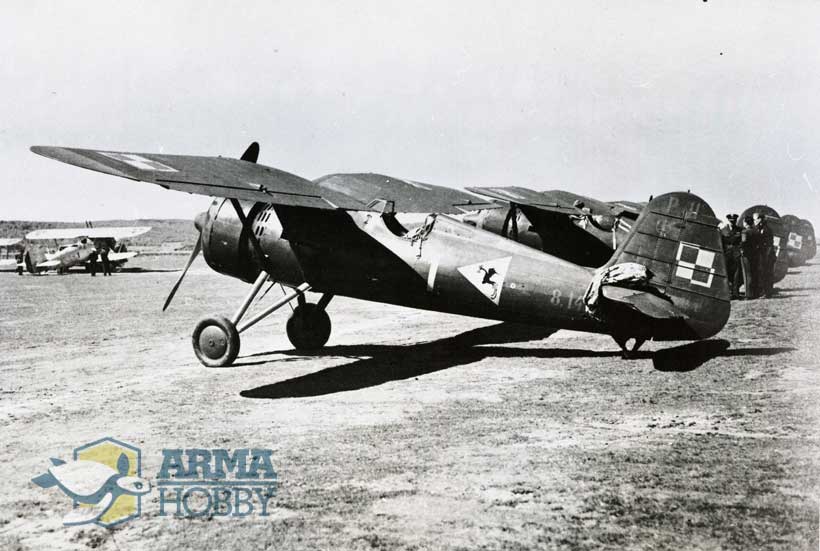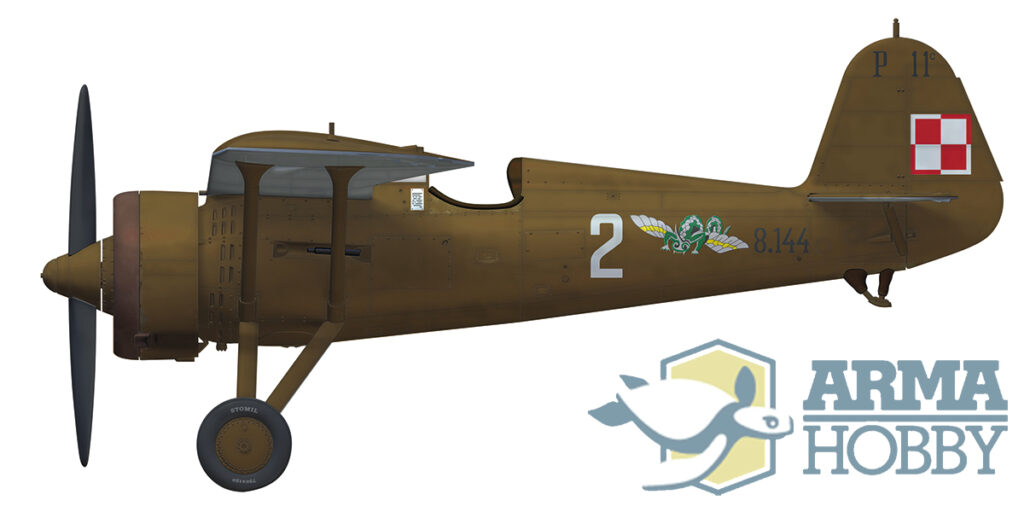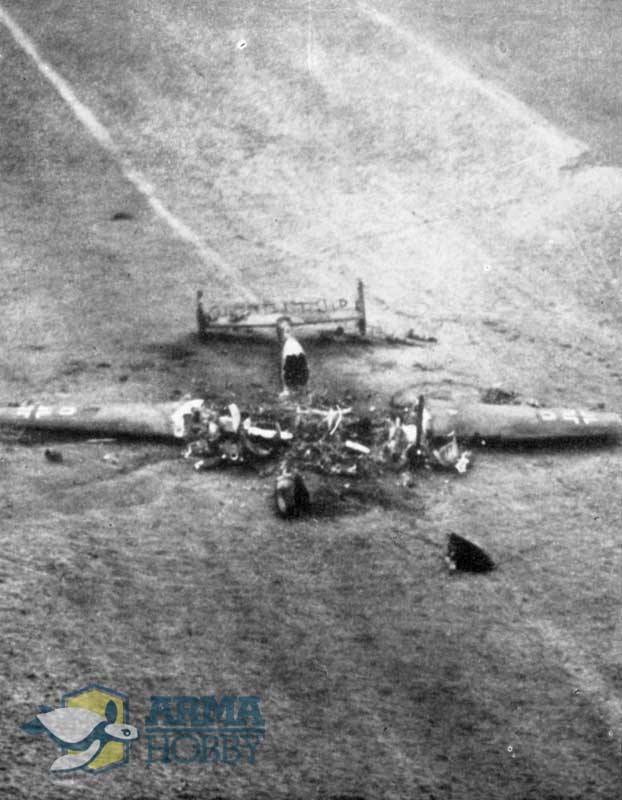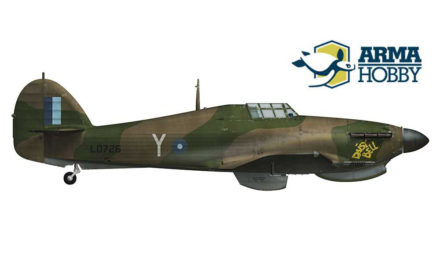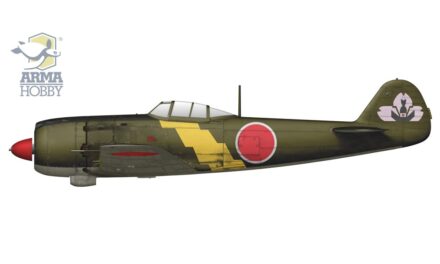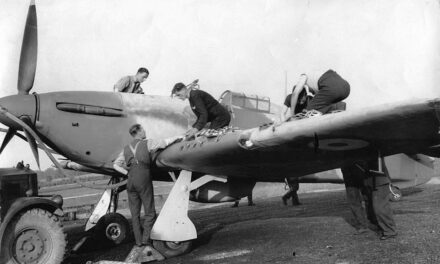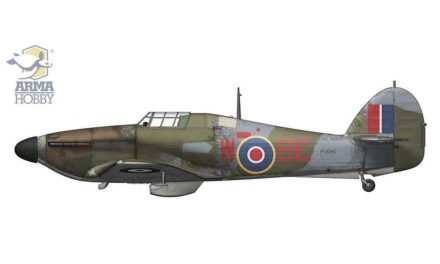The Pursuit Brigade – Warsaw defenders
The Pursuit Brigade, organised in May 1939, was a fighter unit of the Polish Air Force charged with defending the Warsaw agglomeration against enemy air attack. In September 1939, it comprised a total of 5 squadrons (54 aeroplanes) and, in accordance with the wartime organisation of the Polish Air Force, was subordinate to the Commander-in-Chief.
The majority of the squadrons comprising the Pursuit Brigade were stationed at the base of the 1st Aviation Regiment, located at Warsaw’s Okęcie Airport, and it was quickly recognised that in the event of war this facility would constitute an obvious objective of enemy attack. In August 1939, tensions in relations between the Third Reich and Poland reached a zenith, and in light of this, on 29 August 1939, the Commander of the Pursuit Brigade, G/C Stefan Pawlikowski, issued an order for the aircraft to be moved to aerodromes that had been previously prepared in the vicinity of Warsaw.
One of the first PZL P.11c fighter aeroplanes in the Polish military aviation entered the 112th Fighter Squadron. The photo shows “1” with the military number 8.14, photographed in May 1936 during the show in Brommie, Sweden. It was the first time that the PZL P.11c in the service of the Polish aviation was shown on the international arena.
The pilots left Okęcie in squadrons; the first to depart were 114 and 113 Fighter Squadrons, which flew to Poniatów airfield, where they awaited the arrival of reinforcements in the shape of 123 Fighter Squadron from the Kraków-based 2nd Aviation Regiment. Meanwhile, 112 and 111 Fighter Squadrons moved to the aerodrome in Zielonka. Among the aeroplanes of 112 Fighter Squadron which landed in Zielonka and were masked in an artificial forest was a PZL P.11c marked with the number “2”. This aircraft was usually flown by F/O Wacław Łapkowski, who had been a pilot of 112 Fighter Squadron since 1936. He was recognized as an excellent airman and tactician. F/O Łapkowski was the third in the Squadron’s chain of command, after F/L Tadeusz Opulski, the commanding officer, and his deputy, F/O Stefan Okrzeja.
PZL P.11c military number 8.144 (probably), under-wing number N-666, tactical number 2, personal aircraft of F/O Wacław Łapkowski from 112 Fighter Squadron. On the aeroplane you can see a new emblem, “Winged Salamander”, introduced in the summer of 1939 in place of the former “Fighting Cock”. Artwork by Zbyszek Malicki.
The war
Now, they all waited anxiously for the development of events – would it be war or peace? At around 5.00 am on 1 September 1939, the Headquarters of the Pursuit Brigade received the first reports of the Wehrmacht’s attack at numerous points along the Polish-German border. All doubts were dispelled – it was to be war after all! On the morning of that day, F/O Wacław Łapkowski and P/O Jan Daszewski were selected for duty in the quick reaction alert section, but although they expected to be the first to encounter the enemy, fate would have it otherwise. At approximately 7.00 am, the quick reaction alert section from neighbouring 111 Fighter Squadron was scrambled to intercept a German reconnaissance aircraft. More than an hour later, Brigade Headquarters issued an order to scramble and intercept a group of enemy aeroplanes approaching from East Prussia. All of the Pursuit Brigade’s squadrons took off rapidly, however the quick reaction alert section of 112 Fighter Squadron was instructed to remain in readiness on the ground. The first air battle in the defence of Warsaw would soon commence over the River Bug. We can only guess what F/O Łapkowski was feeling, having to remain at the aerodrome while his companions fought in the air.
The growing political tension in Europe after the Munich crisis made it obvious that it was necessary to prepare Polish aviation for a potential conflict with the Third Reich, in the photo PZL P.11a and P.11c fighter planes and in the background PZL.37 Łoś bombers. Photo taken at the turn of February and March 1939 at the base of the 1st Aviation Regiment in Okęcie. (arch. Marek Rogusz)
But before noon that day, number “2”, flown by F/O Łapkowski, also took off for its first battle flight along with 112 Fighter Squadron. Their intended target were German reconnaissance aircraft. With the help of the quick reaction alert section of 111 Fighter Squadron, which had been scrambled in the meantime, 112 Fighter Squadron succeeded in cornering one of the invaders. For the first time in his life, F/O Łapkowski opened fire on an enemy aeroplane; a few of the other pilots started shooting, too. Ultimately, the victory was awarded to F/O Okrzeja, who fired a burst from very close range, whereupon the Dornier Do 17P from 4.(F)/121 exploded and went down in flames, crashing in the township of Świder near Warsaw.
The remains of the reconnaissance Dornier Do 17P from 4. (F) / 121, that was shot down on September 1, 1939 near Świder near Warsaw by pilots of the 111th and 112th Fighter Squadrons. The vicotry was attributed to F/O. Stefan Okrzeja. (press photo)
The second wave
Already before 4.00 pm, the Headquarters of the Pursuit Brigade was receiving a steadily increasing number of reports from the aircraft tracking networking about enemy aeroplanes heading towards Warsaw. It became clear that from the morning the Germans had been focusing more on a reconnaissance in force while waiting for favourable atmospheric conditions, and that the attack proper on the Polish capital had started only now. Between 4.45 pm and 5.30 pm, successive waves of Luftwaffe bombers appeared over Warsaw – approximately 120 Heinkel He 111s from KG 27, II.(K)/LG 1 and III.(K)/LG 1, and 30 Junkers Ju 87B dive bombers from I./StG 1. They were escorted by fighters: some 40 Messerschmitt Bf 110s from I./ZG 1 and IV.(Z)/LG 1, and around 30 Messerschmitt Bf 109Ds from I./JG 21. Weakened during the morning’s fighting, the Pursuit Brigade sent up approximately 40 aeroplanes, however these were unable to stop such a large attack, which had been launched on Warsaw from different directions. The German aircraft broke through to the Polish capital and bombed, among others, Okęcie Airport.
The source of information about the enemy airplanes flying over the territory of Poland was to be a surveillance network, which consisted of about 800 observation and reporting posts located throughout the country. Communication was based on existing telephone lines to save costs and enable it to be put into operation as quickly as possible. For the purposes of the Pursuit Brigade, Maj. Wyrwicki developed a system for dividing the air area around Warsaw into code sectors, which made it possible to quickly direct the planes towards the incoming enemy. This system worked in practice until the public telephone network was damaged as a result of the hostilities. (picture by Roman Postek)
In the vicinity of Babice, the section led by F/O Łapkowski encountered Stukas attacking the Transatlantic Radio Station. When the “elevens” flew in to intercept the dive bombers, they were jumped by their escort of Messerschmitt Bf 109s. At one point, F/O Łapkowski had to fend off the attack of no less than 5 aeroplanes. Luckily, as it was observed, the German pilots were insufficiently aggressive. In the meantime, his wing-man, F/O Daszewski, attacked and damaged one of the Stukas.
When evening fell, the pilots started to sum up the first day of war. There was not the slightest doubt that the Luftwaffe enjoyed a considerable numerical and technological advantage. The “elevens” were unable to catch up with a Heinkel He 111 bomber in level flight, not to mention the Messerschmitt fighters. But the P.11s were, as it turned out, considerably more manoeuvrable. However, the losses which they had incurred were a cause for concern. A discussion commenced as to what tactics should be used in the circumstances. The mechanics had a lot of work on their hands, for half of the aircraft of 112 Fighter Squadron were damaged. P/O Witold Łokuciewski from 112 Fighter Squadron gave the following account:
We are returning to our quarters. Our aeroplanes are being worked on with feverish haste. The mechanics are patching up the bullet-riddled wings and fuselages, inspecting the engines, repairing damaged propellers, and replacing the mangled control surfaces, stabilizers, wheels and tyres.
Days of war
2 September 1939 was by and large devoted to repairing the aircraft which had been damaged during the first day of fighting. 112 Fighter Squadron was scrambled twice to intercept German aeroplanes, but its efforts were unsuccessful. Just before they reached Warsaw, the Germans split into two groups; the “elevens” were unable to catch either outside the capital, while regulations forbade them from flying over the city (with only a few exceptions) because of the risk of being targeted by Polish anti-aircraft artillery.
A downed Messerschmitt Bf 110 photographed by a German propaganda team. It was probably a plane shot down by F/O. Arsen Cebrzyński and perhaps by F/O Stefan Okrzeja during the air fight on September 3, 1939 (press photo)
On 3 September 1939, in order to avoid the debacle of the previous day, when the Germans had been able to avoid interception by the Polish squadrons, sections of three aeroplanes from 112 and 111 Fighter Squadrons patrolled the skies in turn from dawn. At around 8.00 am, one of the first large fighter battles of World War II commenced near Zielonka and Rembertów. At its climax, 18 PZL P.11s from 111 and 112 Fighter Squadrons were fighting with 18 Messerschmitt Bf 110s from I.(Z)/LG 1. The equality of strength was only numerical, however, for the German aircraft were much more heavily armed (4 machine guns and 2 cannons, as well as a machine gun manned by the rear gunner) and more than 100 km/h faster than the Polish P.11s, whose sole advantage lay in their better manoeuvrability. Both sides suffered losses: 2 Polish aeroplanes were shot down and 2 were forced to land on the army range next to which the aerodrome was located, while the Germans lost 2 Messerschmitts shot down and had 2 slightly damaged. The PZL P.11c marked number “2”, flown by F/O Łapkowski, also took part in the battle. But although he did not manage to shoot down a Messerschmitt, he escaped relatively unscathed from the fight, taking just a few shots to the fuselage. The hero of the day was F/O Wojciech Januszewicz from 111 Fighter Squadron, who took off alone to intercept four Messerschmitt Bf 110Bs from 3.(Z)/LG 1 that were approaching the airfield and shot down one of them, while the remaining three soon withdrew.
 F/L Zdzisław Krasnodębski (1904-1980) From January 1938, he commanded the III/1 Fighter Wing (previously the 111th Fighter Squadron). In the war of 1939, wounded and burned on September 3, he remained the commander until he crossed the Romanian border. In France, he was the commander of the Polish section in the GC 1/55. After the evacuation to England, he was the organizer and the first commander of the 303 Fighter Squadron. He was an excellent commander appreciated by his subordinates, whom he could organize and train to become excellent fighter pilots..
F/L Zdzisław Krasnodębski (1904-1980) From January 1938, he commanded the III/1 Fighter Wing (previously the 111th Fighter Squadron). In the war of 1939, wounded and burned on September 3, he remained the commander until he crossed the Romanian border. In France, he was the commander of the Polish section in the GC 1/55. After the evacuation to England, he was the organizer and the first commander of the 303 Fighter Squadron. He was an excellent commander appreciated by his subordinates, whom he could organize and train to become excellent fighter pilots..
Transfer to the new airfields
The Command of the Pursuit Brigade feared that the three days of fighting had led to the exposure of its airfields. For this reason, all of the squadrons were ordered to transfer. Vehicular groups departed for their new locations during the night from 3 to 4 September 1939, while the aircraft flew to the new aerodromes in the early morning of 4 September. 111 and 112 Fighter Squadrons landed in Zaborów, while 113, 114 and 123 Fighter Squadrons moved to Radzików. Both airfields were situated to the west of Warsaw, and were approximately 6 kilometres distant from each other. 112 Fighter Squadron masked its aeroplanes on the edge of the park adjacent to the Palace in Zaborów, in which the officers of 111 and 112 Fighter Squadrons were quartered. 4 September was not a good day for the pilots of 112 Fighter Squadron, for even though they were scrambled a number of times, they did not manage to intercept any enemy aircraft. Meanwhile, 111 Fighter Squadron entered the fray and shot down one Stuka, unfortunately losing one “eleven”, which was destroyed while landing on the difficult and dust-clogged airfield in Zaborów.
The next day, 5 September 1939, was to be very eventful for 112 Fighter Squadron. Following one take-off, at around 2.00 pm, its pilots encountered two groups of German aircraft. The squadron duly divided itself into two parts, one of which attacked a flight of Junkers Ju 87s from 11.(St)/LG 1, shooting one down. The other part of 112 Fighter Squadron proceeded to intercept a force of Dornier Do 17Zs from 3./KG 2, however it fared less well. F/O Łapkowski, who commanded one of the sections, described the events thus:
(…) After a while – as a matter of course – we started receiving order after order from the ground. Our direction, assembly point, height, and the number of enemy aircraft were changed every second. After a few minutes of this “Devil’s Dance”, we found ourselves over the Warsaw – Wołomin railway line at a height of 3,000 m. (..) A couple of minutes later, looking to the north-east, I saw a few distinct lines on the horizon. It was a squadron of Dornier Do 215s. Stefan Okrzeja also saw the enemy and said to me over the radio: “Look right”. I responded: “I see them”.
We accelerated, full boost, and pulled on our yokes. We cut across their path! The Dorniers increased speed and turned north. But it was too late. We were on the attack. I and my wingman focused on one enemy section, while Stefan turned his attention to the other. That was the last I saw of Stefan. The Dorniers gave us a hearty welcome. We responded in kind. Unfortunately, the fight had no end product, for after the first attack the Dorniers dived and fled. We flew back to base. Okrzeja and Nowakowski did not return. We later learned that Okrzeja had been killed, while Nowakowski was wounded. They had collided during their attack. It could have been that by that point Stefan had already been wounded by enemy fire.
But this was not the end of the day’s fighting for 112 Fighter Squadron. Soon after 5.00 pm, it was scrambled once again, this time to intercept a dozen or so Heinkel He 111s from II.(K)/LG 1, which were bombing military facilities between Małkinia Górna and Mińsk Mazowiecki. The bombers were escorted by a squadron of Messerschmitt Bf 110s from I.(Z)/LG 1, which proceeded to attack the Polish fighters. The Commander of 112 Fighter Squadron, F/L Opulski, gave the following account of the battle:
I signalled to the pilots to attack from an advantage of height. During this manoeuvre we were bounced by a large number of Messerschmitts. Their orange snouts quickly grew larger and larger (…). The Messerschmitts surrounded us and opened a hail of fire (…). I signed to Krawczyński that we were leaving the fray. We had to save ourselves.
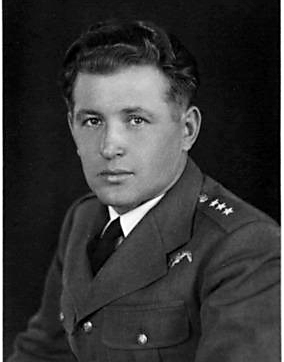 After returning to their home base, the German fliers reported having shot down one Polish fighter; in reality, they had only damaged Opulski’s aircraft. Dr Jerzy Pawlak, a Polish historian of military aviation, observed that on 5 September 1939 F/L Tadeusz Opulski returned to the aerodrome on P.11 number “2”, which had been damaged by Messerschmitts. Exhausted, the pilots retired for the night. The mood among them was not the best – their deputy commander had just perished. Meanwhile, the news from the front grew more and more worrying: German units had broken through the Polish defences and were advancing rapidly towards Warsaw.
After returning to their home base, the German fliers reported having shot down one Polish fighter; in reality, they had only damaged Opulski’s aircraft. Dr Jerzy Pawlak, a Polish historian of military aviation, observed that on 5 September 1939 F/L Tadeusz Opulski returned to the aerodrome on P.11 number “2”, which had been damaged by Messerschmitts. Exhausted, the pilots retired for the night. The mood among them was not the best – their deputy commander had just perished. Meanwhile, the news from the front grew more and more worrying: German units had broken through the Polish defences and were advancing rapidly towards Warsaw.
F/L Tadeusz Opulski (1906-1943). From 1938, he commanded the 112 Fighter Squadron, with which he went all the campaign in September 1939. He evacuated to France, where in 1940 he commanded the DAT section “Op” (ELD / Romorantin). After the defeat of France in England, he was sent to the 303 Fighter Squadron, but due to his health condition, he did not receive training for fighter planes. He retrained as a bomber pilot while training on Wellington bombers in 18 OTU died during a training flight.
On 6 September 1939, 112 Fighter Squadron entered the fight in the early morning, soon after 5.00 am, when Junkers Ju 87Bs from IV.(St)/LG 1, escorted by Messerschmitt Bf 110s from I./ZG 1, appeared west of Warsaw. During the engagement, the Polish pilots probably shot down one Stuka, but the P.11a flown by AC1 Zygmunt Rozworski was severely damaged by a Messerschmitt Bf 110 and barely made it back to the airfield in Zaborów. Three hours later, in the course of a subsequent encounter with Messerschmitt Bf 110s, 112 Fighter Squadron lost another aeroplane, however its pilot, AC1 Leon Nowak, bailed out to safety.
The crisis
The pilots of the Pursuit Brigade were by then aware that the situation was deteriorating. They saw that the Germans had an increasing advantage in the air, whereas their own logistical support was slowly failing: ammunition belt links and propellers were in insufficient supply, while replacement aircraft were practically unavailable. The Pursuit Brigade was finding it more and more difficult to intercept the waves of German bombers attacking Warsaw. As it turned out, the aircraft tracking network, which relied heavily on the public telephone grid, had become disorganised. In consequence, pilots were scrambled too late, while the orders which they received frequently sent them to sectors where there were no German aeroplanes.
Shortly after noon, the aerodrome in Zaborów received an order from the Commander of the Pursuit Brigade to perform a sweep in the area of Koło – Kutno – Łowicz in order to provide Army Poznań, which was withdrawing from the west, with aerial protection against Luftwaffe attacks. The task was allocated to 113 and 114 Fighter Squadrons and one section from 112 Fighter Squadron, while the remaining aircraft were left at base in readiness to protect Warsaw.
A section comprising F/O Wacław Łapkowski (Salamander “2”) and two wingmen – OC Janusz Marciniak and AC1 Władysław Wieraszka – took off from Zaborów. Once airborne, they rendezvoused with the section led by F/O Tadeusz Sawicz (Swallow “4”) from 114 Fighter Squadron, which also included LAC Andrzej Niewiara and AC1 Jerzy Zieliński. After flying for some 170 kilometres, at 3.10 pm, while south-west of Koło, the pilots noticed 9 Heinkel He 111Hs from 4./KG 26, which were flying in a south-easterly direction. F/O Wacław Łapkowski gave the following account:
(…) The River Warta was right in front of us. A squadron of Heinkel He 111s was flying along it. Our wing met them practically head-on, and that is how we commenced our attacked. This is pointless, I thought to myself. I was the highest up, so I and my section made a turn above the Heinkels and attacked from behind and above, enjoying a considerable advantage of height. Finally, I had my chance. I saw the gunner’s “snout”, and the flashes from his machine gun barrels. I pressed the trigger. My machine guns responded. A burst … one more … and one more still. Suddenly, there was a great tangle all around me. The boys were finishing off the remaining two planes from the section of He 111s. Someone, carried away with enthusiasm, even attacked me. In the meantime, “my” He 111 had fallen behind its section. The gunner was no longer shooting. One of the engines was billowing smoke. The enemy banked right and, in a slight dive, started descending. A “stable” machine, I thought to myself. I gave him one more burst. I resented him for not bursting into flames. The aircraft continued to descend, however, and a few moments later it was lying in a meadow by the Warta.
The Heinkel He 111H (1H+AM) was hit mainly by pilots from the section from 112 Fighter Squadron, although it was also attacked by their colleagues from IV/1 Wing. The bomber bellylanded in the village of Ruszków Drugi, some 3–4 km south of Koło. While returning to base, the loose and, perforce, mixed group of “elevens” encountered another formation of German bombers, but at that very moment OC Marciniak ran out of fuel and was forced to land. Some time later, both pilot and plane returned to their unit.
Abandoned at the field airfield in Zaborów, PZL P.11a No. “7” (military number 8.35, under-wing 712-N) from the 112 squadron, which was supposedly piloted by S/Ldr Zygmunt Rozworski on 6 September 1939. On the wreckage you can see the cut remains of the “Salamander” emblem. The plane was set on fire by Polish soldiers leaving the airport, the damage shown in the photo was caused by the explosion of the gasoline tank. (arch. Marek Rogusz)
Farewell, Warsaw!
Witold Łokuciewski from 112 Fighter Squadron recalled the commotion which followed receipt of the order of General Józef Zając, the Commander-in-Chief of the Air Force and Anti-Aircraft Defences:
In the evening the Brigade Commander, duly instructed by the Commander-in-Chief of the Air Force, issued an order to move to the Lublin airfield network. For us, this came as a surprise. As did many other orders given during the War. It led to widespread speculation and gloomy comments. Ultimately, however, an order is an order.
Work on organising the vehicular groups started forthwith. However, the insufficient number of trucks, coupled with the sheer volume of squadron assets, resulted in the move being broken down into stages – even though some of the equipment was left behind and hidden on base. The journey to Kierz, along a road jammed with refugees and under constant attack by the Luftwaffe, was a veritable ordeal for the ground crews, tired as they already were. As regards the flight of the air group to the Lublin area, P/O Mirosław Ferić had this to say:
We were given the order to fly to the city of Kierz near Lublin. Wojtek led 111 Fighter Squadron, and Łapkowski 112 Fighter Squadron. The airfield itself, located near a high mixed forest, wasn’t too bad. Once a swarm of RWDs and some others were told to fly off, the planes were masked along the treeline. From time to time, whirling clouds of dust – caused by the long-standing drought – would pass over the field.
English translation by Maciej Zakrzewski
See also:
- Buy 40001 PZL P.11c Expert Set 1/48 and more in Arma Hobby online shop!
Aeronautical engineer not working in his profession. History of Polish aviation 1918-1945 – its machines and people - is his greatest passion. Marek hunts for forgotten stories, helps to establish the fate of aviators and cooperates in Polish airplanes identification during archeological excavations. Author/co-author of many books and articles, incl. Polish Fighter Colours 1939-1947 vol. 1.
This post is also available in:
 polski
polski


